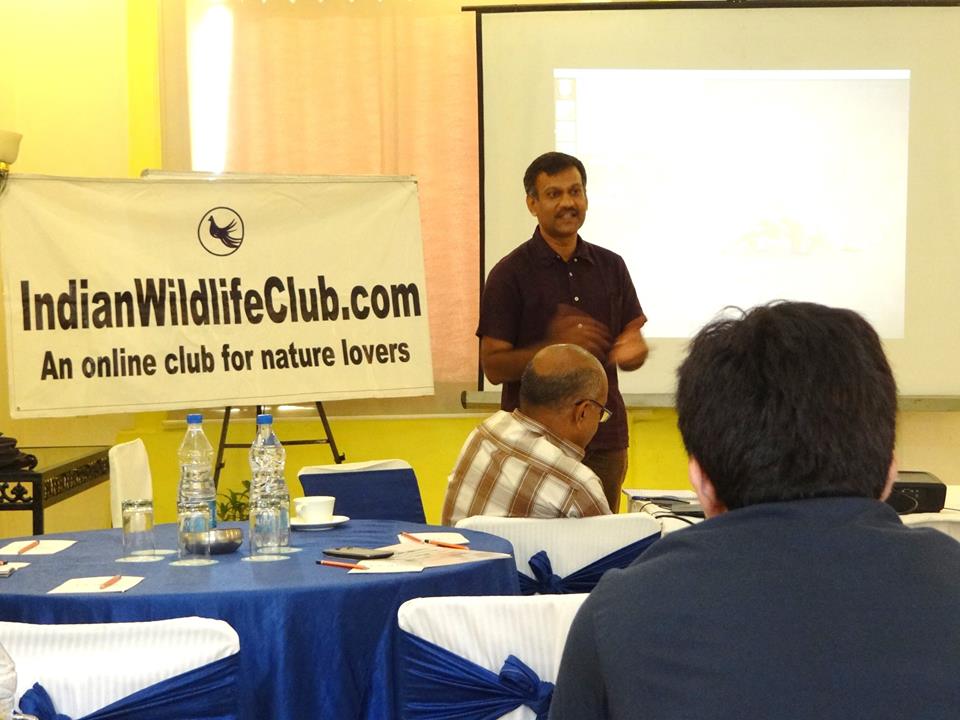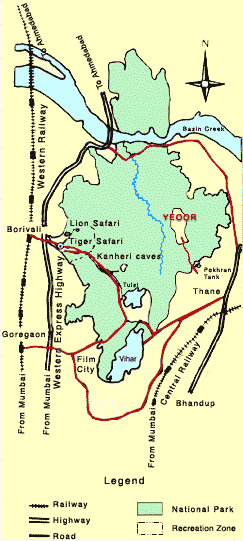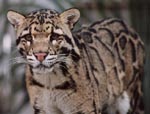Amazing Facts About Wildlife
 By
By
Prashant Mahajan, senior Education Officer, BNHS, Mumbai
Why do birds migrate?
The answer to why some birds migrate while others don't is not as simple as
it seems. Ornithologists have studied the phenomenon for many years and still have not come up with an accurate explanation.
Birds mostly migrate long distances in order to escape from extreme cold, diminishing food supply and rapidly shortening days. Birds do not get sufficient time to search
for food because of shortening days in their breeding grounds. This motivates them to migrate. These are only few of the several theories about migration but none is able to provide a fully satisfactory explanation. Their stay in winter is confined to only
a few weeks after which they set out again on the return trip to their nesting grounds.
More is known about where and how the birds migrate, and on which routes. Answers to these questions have been found with the aid of high-powered radar equipment, aircraft
and short wave transmitters. Today there are bird ringing stations in all parts of the world which mark individual birds by putting a ring around the bird's leg with an identification number and the address of the respective country's ringing scheme. Recovered
rings are sent to the respective ringing country's ringing scheme's headquarters that can then plot maps of migration. These are added and updated every year on the basis of information received from other ringing schemes through the world.
This makes it possible to determine the route, speed of flight and winter destination of some species. The Bombay Natural History Society has studied Bird Migration at various
places in India. Birds were ringed at Bharatpur, Chilka, Harika, Karera etc. The birds ringed were reported at Moscow, Novosibirsk and shores of the Caspian Sea.
How do they find their way?
It is amazing that birds always find their way back to their nesting ground after traveling from as far away as 1000 kms. It would seem, then, that birds must have an innate
sense of long-distance orientation. But what leads them to their goal? This aspect has been studied by many scientists for years. One theory states that birds are directly influenced by the earth's magnetic field and they are able to distinguish the various
points of the compass. However modern instruments reveal that the earth's magnetic field has only slight influence on birds. The other theory based on observation and experiment states that birds navigate by means of light or by the position of the sun, the
moon and stars. This becomes possible even when the sky is overcast, but not in very foggy condition.
Travel Per day:
In most birds a migratory journey is not made non-stop as many people once believed. Some birds travel about 100 km a day while others cover as much as 300 to 600 kms a day.
On the way they may stop, rest and obtain food. In bad weather, especially if it is foggy, they even remain in one place for several days.
- Speed of travel: The speed of a bird on migration varies according to the species but is always less than that of which it is capable over short distances. Some birds fly
50 Kms per hour whereas few do 74 kms per hour.
- Flight Formation: Some species migrate in flocks, but some make the flight alone or in small groups. Some migrate by day; others travel by night and few both by day and
night. The birds traveling in flocks form their own formations such as V shape or slanting lines, as the ones in front disturb the air for those behind. The birds sometimes take turns as leader e.g. Grey-lag Geese and Demoiselle Cranes.
- Altitude: Birds travel at various altitudes. Small birds usually fly upto 100 meters and most raptors at a height of about 1000 meters. When they want to cross high mountains
they can fly even higher.
- Total Distance travelled: The distances some birds travel, when migrating, are almost unbelievable. Many birds fly as far as ten thousands kilometers twice a year, in winter
and in summer. The Arctic Tern migrates twice each year from Arctic Winter to Antarctic Summer and back again covering distances of over 17,000 kms each way!
|
Answers To Quiz Of The Month
Mr. Jayant Deshpande of Pune, Maharashtra ( j_deshpande@yahoo.com) is the only respondent who clicked all ten correct answers before 7th of November. Jayant will receive
a surprise gift by mail
Correct answers are shown in red.
1.Asian elephants have a life span of --------------- years.
| O 30-40 years
|
O
60-70 years
|
O 80-90 years
|
|
|
2. Asian elephants were widely tamed more than ---------------- ago
| O 1000 years |
O 2000 years |
O 4000 years |
|
|
3. The forest department used the method of ----------------to catch wild elephants in India.
| O Kumki |
O Khedda |
O Khotal |
|
|
4.The lustrous white dentin called ivory are actually--------------------- of elephants.
| O upper molars |
O upper incisors |
O horns |
|
|
5. Elephant families are--------------------------
| O patriarchal |
O matriarchal |
O neither of these. |
|
|
6.Elephant babies are carried by their mothers for---------------months.
| O 9 months |
O 5 months |
O 22 months |
|
|
7. 'If the tiger is the spirit of the
jungle, the elephant is its body' Who wrote these words?
| O Katharine Payne |
O Dereck Joubert |
O Raman Sukumar |
|
|
8. To ensure long term survival of elephants, in addition to forests, forest--------------are to be protected
| O paths |
O fauna |
O corridors |
|
|
9. The species closest to elephants are,
| O rhinos |
O dugongs |
O hippos |
|
|
10.The national animal of India is the ---------------------
| O elephant |
O tiger |
O lion |
|
This month we have put on line a quiz on the tiger, India's national animal. The first two all correct answers attempted online before 7th of December will get special gifts.Click
here for quiz on tiger
|
Lesser mammals
 Toby Ninan retired from Delhi Zoo about two years back. With his varied experiences with the wild animals in
the zoo, he is the right person to direct your queries to. Hear what Ninan has to say about his life and chosen career! Toby Ninan retired from Delhi Zoo about two years back. With his varied experiences with the wild animals in
the zoo, he is the right person to direct your queries to. Hear what Ninan has to say about his life and chosen career!
No matter how humble we may feel or act most of us would certainly like a bit of massaging and uplifting of our egos.
One of the things that gives a 'Zoo Man' a great lift is when he is called out to capture a wild animal that has 'invaded' 'human' habitation. ...Well, monkeys in Delhi do this quite often and may I confess that
this happens usually when one is at his lowest ebb and works miracles on his feeling of well being.
When out to capture a wild animal especially one of the primates all the basic cunning and predatory instincts have to play a great part along with one's skills of using tranquillizing equipment.
A very dejected press photographer came to my office at about 5.00 p.m and told me that he did not get a single picture or story for his news editor and wanted me to razzle up a story for him. Well, a few minutes
before his arrival I had received a phone call from the P.M.O (Prime Minister's Office) telling me to come to the North Block of the Central Secretariat near the P.M's office to capture and take away a somewhat sick monkey who was quite a nuisance around there.
I told the press man to follow our car but if anyone had questioned either of us we were not to show any recognition of the other.
The monkey, a big fat fellow with all the signs of obesity was sitting on the top of a ledge near one of the gates of the P.M's office. When lured with some food, he came out of the building and made himself comfortable
on the roof of a cycle stand. A large number of office staff, security men and curious bystanders were in attendance.
Taking a deep breath, I aimed the blow pipe at the animal and blew hard. The dart was true and hit the big fellow on his backside. In about three minutes the cocktail of drugs (big as he was) began to take effect
and with a big thud the animal dropped five feet to the ground. He was sandwiched among some cycles and in a trice my driver and I gathered him together in a gunny sack and dumped him inside the car.
The photographer was not lacking and he would get every bit of the action on film and even helped both of us in the final phase of putting the monkey in the car.
Well the photographer got his story and I got my "man".
The pictures appeared on the fifth page of the newspaper which was read by another newspaper man who gave me an opportunity to fly 3000 miles forth and back along with all V.I.P treatment to capture more monkeys!!
Toby Ninan can be contacted at Ninan@indianwildlifeclub.com
|
News and Views
A film on Painted storks- Migratory birds of India Review by Susan Sharma
 Kokkre Bellur in Karnataka means 'Bird Village'. Come November every year, the branches of the old tamarind and peepal trees are teeming with feathered activity as flocks
of Painted Storks (lbis leucocephalus) and Spot billed Pelicans (Pelecanus philippenis) descend on this hamlet to build their nests and rear their young. Kokkre Bellur in Karnataka means 'Bird Village'. Come November every year, the branches of the old tamarind and peepal trees are teeming with feathered activity as flocks
of Painted Storks (lbis leucocephalus) and Spot billed Pelicans (Pelecanus philippenis) descend on this hamlet to build their nests and rear their young.
The Simsha river and a few other ponds in the vicinity provide the endless supply of fish these waterfowl require during the breeding season.
As for the villagers, these Painted Storks and pelicans have come to be an integral part of their lives. Says one village elder, " These birds are like our bothers and sisters,
we wait for them to come every year". The locals also believe that the non-arrival of these birds is an ill-omen. One of them earnestly told us, " A few years ago, these storks didn’t come and we had a murder in our village". More scientifically, these waterfowl,
like most animals, can sense disturbances in nature and skip their breeding cycle in years of sparse rainfall. No wonder then, the farmers dread their non-arrival. And the guano that these birds so generously splatter over the tiled roofs and courtyards is
valuable manure.
Over the years, though, the number of Spot-billed Pelicans and Painted Storks arriving in Kokkere Bellur has declined drastically. Naturalists attribute this to the dwindling
number of trees and the resulting overcrowding of nests. Says Theodore Baskaran, naturalist and regular visitor to Kokkere Bellur "As a result of overcrowding many fledglings fall out of their nets and die". But local bird watching groups and NGOs (non-government
organizations), along with assistance from the Forest Department have taken measures. "A nursery has been set up to hand rear these fledglings that have fallen out" explains Baskaran, "these are right under the trees so that the little ones can still watch
their parents and learn from them-an association with the wild which is critical for any project of this kind". And along with this, conservationists have also taken to planting saplings and involving in the locals in their efforts.
The film
'The Wings of Kokkre Bellur'
by K.P.Sasi is a tribute to all the unknown and uncelebrated communities that live in harmony with nature.
|
Story Of The Month
By Sushant Sharma,
Member, IndianWildlifeClub.com
sushant01@hotmail.com
 After reading about the plight of
Borivili (East) hills , Mumbai, I decided to visit the West side of Borivili Hills whch is also known as Sanjay Gandhi National Park. The park is described as the Green Lung of Mumbai and treks and trails criss cross the park. After reading about the plight of
Borivili (East) hills , Mumbai, I decided to visit the West side of Borivili Hills whch is also known as Sanjay Gandhi National Park. The park is described as the Green Lung of Mumbai and treks and trails criss cross the park.
At the gate we were told that there is no arrangement for any kind of transport to Kanheri caves. We can walk if we wish. And walk we did. The trails along the monorail track
were littered with waste and human excreta. We had to watch each step. But soon the overpowering stench was so unbearable that all we wanted to do was return to the clean air of Mumbai.
Here are some pictures of the Park which I took. They tell a story which do not need any words. If anyone is interested in knowing what the park was meant to be and can still
be with some political will, here is the linkhttp://www.borivilinationalpark.com.
|
Tips On Beauty Without Cruelty
|
 Deepika Vohra served as the head of the Department of Beauty Culture at the International Polytechnic for Women at New Delhi. She also ran a beauty clinic at Delhi's Vasant Kunj for some time from
where she relocated to New York for five years. Exposure to the world capital of beauty and cosmetics gave her an opportunity to compare the Indian beauty industry with the razzle dazzle of the New World. Reading and researching beauty culture has always been
a hobby with her. The tips for beauty given below were selected from her repertoire of nature based recipes which are time tested to deliver. Deepika Vohra served as the head of the Department of Beauty Culture at the International Polytechnic for Women at New Delhi. She also ran a beauty clinic at Delhi's Vasant Kunj for some time from
where she relocated to New York for five years. Exposure to the world capital of beauty and cosmetics gave her an opportunity to compare the Indian beauty industry with the razzle dazzle of the New World. Reading and researching beauty culture has always been
a hobby with her. The tips for beauty given below were selected from her repertoire of nature based recipes which are time tested to deliver.
|
|
'Nature Never Did Betray the heart That Loved Her.'-Wordsworth
|
|
The present times herald a veritable victory over chemical cosmetics in the formof natural
beauty aids. Joy, happiness and confidence for sure contribute vastly to your beautiful appearance. A smooth supple skin is of course an added bonus. So, here are some tips to care for your skin through the seasons.
Basic skin types may be classified into five broad categories- normal, dry, oily, combination and sensitive skin. The skin is made up of protective layers
of cells supported by nerves, glands and blood vessels. Your skin lives and breathes. Cells move up to the surface where they are shed and replaced. This topmost layer is protected by the body's natural oil and moisture. It is essential to carefully plan out
a beauty routine to attain a flawless, petal-soft complexion.
The first step to your beauty routine is cleansing your skin. Cleansers are formulated to remove surface grime and dirt as well as dissolve stale make up from the skin.
A gentle massage will help to float out deep down make up and other impurities.
How do you recognize your skin type?
NORMAL SKIN ---is finely textured with no
visible pores, spots, or blemishes, soft and velvety to the touch, and unwrinkled. Normal skin has to be treasured and preserved, as it is liable to change, if neglected.
OILY SKIN --- is caused by overactive sebaceous glands
that give rise to large open pores. Larger pores, in turn, lead to blackheads, blemishes and acne. The appearance of blackheads and blemishes is due to clogged oil and dirt in the pores which is not removed instantly by cleansing. Oily skin begins to have
an oily shine within a few minutes after wash or make-up. This makes it difficult to hold make-up. However, oily skin has an advantage of ageing very slowly, but deep cleansing must be thorough.
DRY SKIN ---
is a sensitive skin type which comes in blotches, tends to peel off easily and feels tight after a wash. Lack of moisture results in dry skin and this skin type is more prominent around the eyes,
mouth, lips, sides of mouth, and forehead. Cleansing, toning, moisturizing form an integral routine of this type of skin. Dry skin is highly susceptible to diet, extremes in weather and harsh perfumed skin care products. Dry skin also has another disadvantage.
Wrinkles appear faster giving you a prematurely aged look. A generous application of moisturizer will produce a skin which would be on par with the 'enviable' peaches and cream complexion.
COMBINATION SKIN---
As the word 'combination' suggests it is mix of two different skin types on one face. More often this skin type is the result of a badly cleansed and neglected skin. It is easily recognizable
as it is oily down the T panel, that is the forehead, nose, chin. The skin gets this oily look down the T panel while the rest of the face appear and feel dry. Combination skin needs scrupulous cleansing. It is a good idea to use a face mask for oily skin
down the T panel and a mask for dry skin for the rest of the face. This method of treating the combination skin works ideally to give a perfect, balanced effect.
SENSITIVE SKIN---- This type of skin is extremely delicate
and vulnerable. It is easily susceptible to freckles, itchy spots and blotches. Dermatitis and allergies caused by chemical cosmetics are common problems of a sensitive skin. It is best to discontinue the usage of strong and harsh skin care products as well
as perfumed creams and moisturizers.
|
FACIAL MASSAGE
At least once a week, a deep cleansing routine is a must for a clear complexion. We have seen various types of cleansers which
can be used depending on the skin type.
The next step to cleansing is a good facial massage which can be done with the help of a good cold cream or massage oil. Facial massage revives and conditions your skin. It improves blood circulation and erases
every tension present in the facial muscles.
A massage is necessary for all skin types. Massage done with the right technique, helps to tone and firm up the sagging muscles. When applying cream use both your hands and stroke gently working your way from throat
to chin, to ears, brows to temples and eye area. Start from the outer corner of the eye, move towards the tear duct and move on to upper eyelids. Remove cream using the same technique.
There are oil based as well as moisturizing nourishing creams. Creams, lotions, skin foods, vitaminized creams and anti-wrinkle creams are all nourishing preparations used for various skin types.
OLIVE OIL NOURISHING CREAM
- 3 Tbspn olive oil
- 2 Tbspn coconut oil
- ½ Tbspn bees wax
- ½ Tspn borax
- 3 Tbspn water
METHOD
Heat the oil slightly. Heat and dissolve completely the borax in the water. Slowly add the heated borax water to the oil until the mixture becomes thick. Cool and store in a jar.
VITAMINIZED NOURISHING CREAM
- 1 Tbspn Bees wax
- 1 Tbspn Emulsifying wax
- 3 Vitamin E capsules
- 3 Vitamin A capsules
- ½ Tspn Almond oil
- ½ Tspn borax
- 1 to 2 drops of tincture of Benzine
METHOD
Melt waxes by the double boiling method; simultaneously dissolve borax in warm water. Add the water to the wax; beat until it cools slightly. Squeeze out oil from the capsules and add to the mixture. Add a drop of
benzine and whisk until it thickens.
ORANGE NOURISHING CREAM
- 2 Tspn witch hazel
- 2 Tspn fresh orange juice
- 2 Tspn glycerin
- 2 Tspn olive oil
- 8 Tspn grated Pears soap
- 4 Tbspn cold water
METHOD
Add water to the soap and heat over a low fire until the soap dissolves. Remove from heat, add olive oil, glycerin, orange juice and witch hazel stirring continuously. Place back on low flame and stir until it begins
to thicken. Transfer to a glass jar and allow it to settle for at least 10 days before using it.
EFFECTIVE SUBSTITUTE FOR COLD CREAM
Equal parts of lemon juice and glycerin is an excellent cold cream substitute that may be used at bed time.
Vegetable and fruit based cleansing masks.
|
|
Extract the juice of potato and add Fuller's Earth to make a thick paste. Apply on face and rinse off. |
| |
|
Cucumber juice combined with Fuller's Earth also helps to cleanse deep down dirt and grime from your skin. |
| |
|
Mashed strawberries have excellent cleansing properties.
|
| |
|
Ripe, mashed papaya, leaves skin clean, smooth and shining.
|
| |
|
Boiled and mashed turnips combined with a little yogurt also cleanses the skin.
|
| |
|
Other natural cleansers include aloe, lemon and ginseng.
|
Deepika Vohra can be contacted at
deepika@indianwildlifeclub.com
|
Understand The Animals
Status: Vulnerable/Endangered, Schedule I
Ashish Kumar, Wildlife Institute of India (ashishkmr@usa.net)
Distribution
 The four sub-species of Clouded leopard Neofelis nebulosa are found in parts of eastern
Nepal, northeast India, southeast Asia (evergreen forests up to 2,500m) and southern China. Surveys suggest that Borneo has the maximum density of Clouded leopards, that is one individual/4 sq km. Within India, it occurs in the rain forests of the northeastern
region in north Bengal (Buxa Tiger reserve), Arunachal Pradesh (Namdapha Tiger Reserve), Assam (Manas Tiger Reserve) and Meghalaya (Balpakram National Park). The species is extremely rare in Meghalaya and at the verge of local extinction. It is believed that
the Taiwanese subspecies N. n. brachyurus has already become extinct. The four sub-species of Clouded leopard Neofelis nebulosa are found in parts of eastern
Nepal, northeast India, southeast Asia (evergreen forests up to 2,500m) and southern China. Surveys suggest that Borneo has the maximum density of Clouded leopards, that is one individual/4 sq km. Within India, it occurs in the rain forests of the northeastern
region in north Bengal (Buxa Tiger reserve), Arunachal Pradesh (Namdapha Tiger Reserve), Assam (Manas Tiger Reserve) and Meghalaya (Balpakram National Park). The species is extremely rare in Meghalaya and at the verge of local extinction. It is believed that
the Taiwanese subspecies N. n. brachyurus has already become extinct.
Habitat
Clouded leopard is believed to inhabit only dense evergreen forests mainly high forests. However, it has also been reported from coastal mangrove swamps, coniferous forests,
secondary or selectively logged forests, grasslands and even degraded dry woodland and scrub.
Cover requirement
Clouded leopard is an extremely good climber, foraging in trees and uses them for resting. It prefers the deep forest away from human habitation. It now appears that trees
are used primarily for resting sites, and clouded leopard movements are typically terrestrial. It builds nests in trees and is most active in early mornings and late afternoon. It may also inhabit more open forested terrain and swamp margins. Swim well and
uses riparian habitats. It prefers areas devoid of tigers and leopards. The clouded leopard has been observed to travel horizontal branches by hanging beneath them like a sloth and to dangle from a branch using only its hind legs. This hanging posture, using
only the hind legs, has been observed in relation to hunting techniques.
Feeding requirement
Clouded leopard is rain forest dweller and depends upon the forest and its intricate web of plants and animals for survival. It hunts mainly on the ground at night. Clouded
leopard-s is opportunistic predator. Recorded preys are different primate species, sambar, barking deer, birds, wild pig, civet, primates, squirrels, porcupines, fish, reptiles, domestic cattle and chickens. Red Jungle fowls and Khaleej pheasants are its major
prey among birds. Lying motionless on overhanging branches, clouded leopards often spring on unsuspecting prey from above, or stalk and capture prey, on the forest floor, by traditional field hunting techniques.
Breeding/rearing requirement
The cubs usually born in a hollow tree. Most litters consist of two cubs but four or even five have been born in captivity. Cubs can walk when they are about 20 days old.
If allowed, they will continue to suckle for five months. Males are said to develop faster than females and they achieve adult coloration when they are about six months old. LIFE SPAN: – 10-15 years in the wild; 17 years in captivity.
Threats
Throughout its range the animal has been heavily hunted for its teeth, which are sold in Asian markets for decoration and bones for medicine preparations.. The clouded leopard
has been persecuted for its coat for many years. People desire coats made of this fur because of its unique pattern. It takes about 20 to 30 cats to make one full-length coat. Clouded leopard has even appeared on the menu of restaurants in Thailand and China
that serve wealthy tourists. This coupled with the loss of habitat, mainly due to deforestation, has led to the animal being endangered. It is a victim of hunting and has been poisoned due to livestock predation.
Two individuals of clouded leopard were radio collared during 1999 in Thailand and tracking of these two individuals indicated requirement of a large home range about 33-36
sq km. I got this important piece of information through my personal communication with Ms. Nora B Fletchall.
|